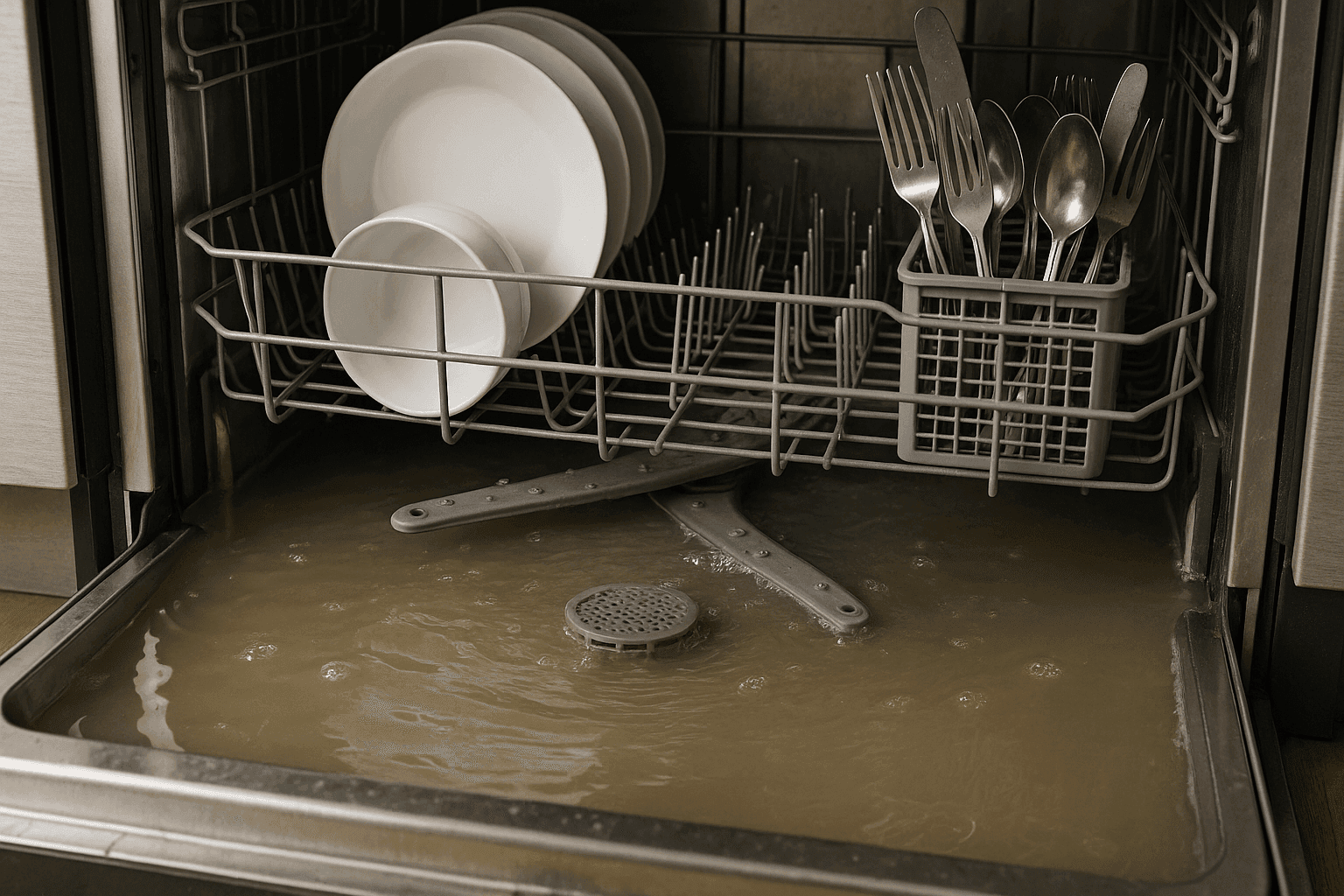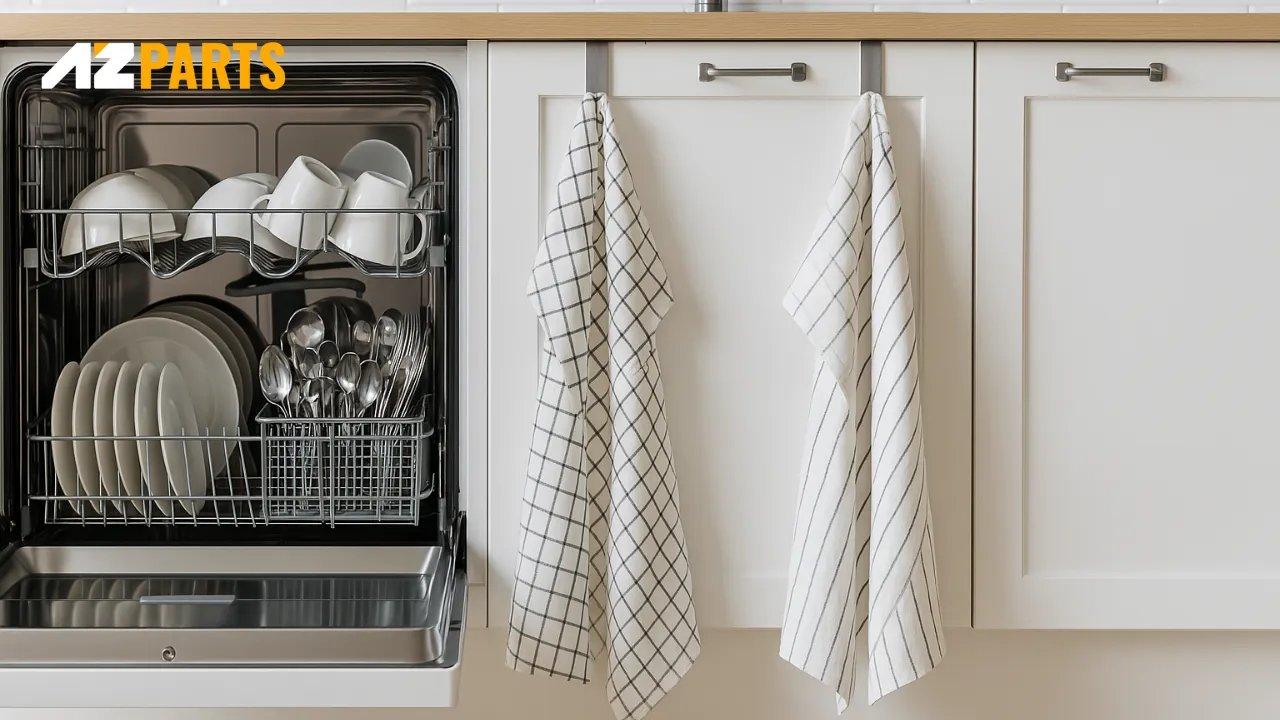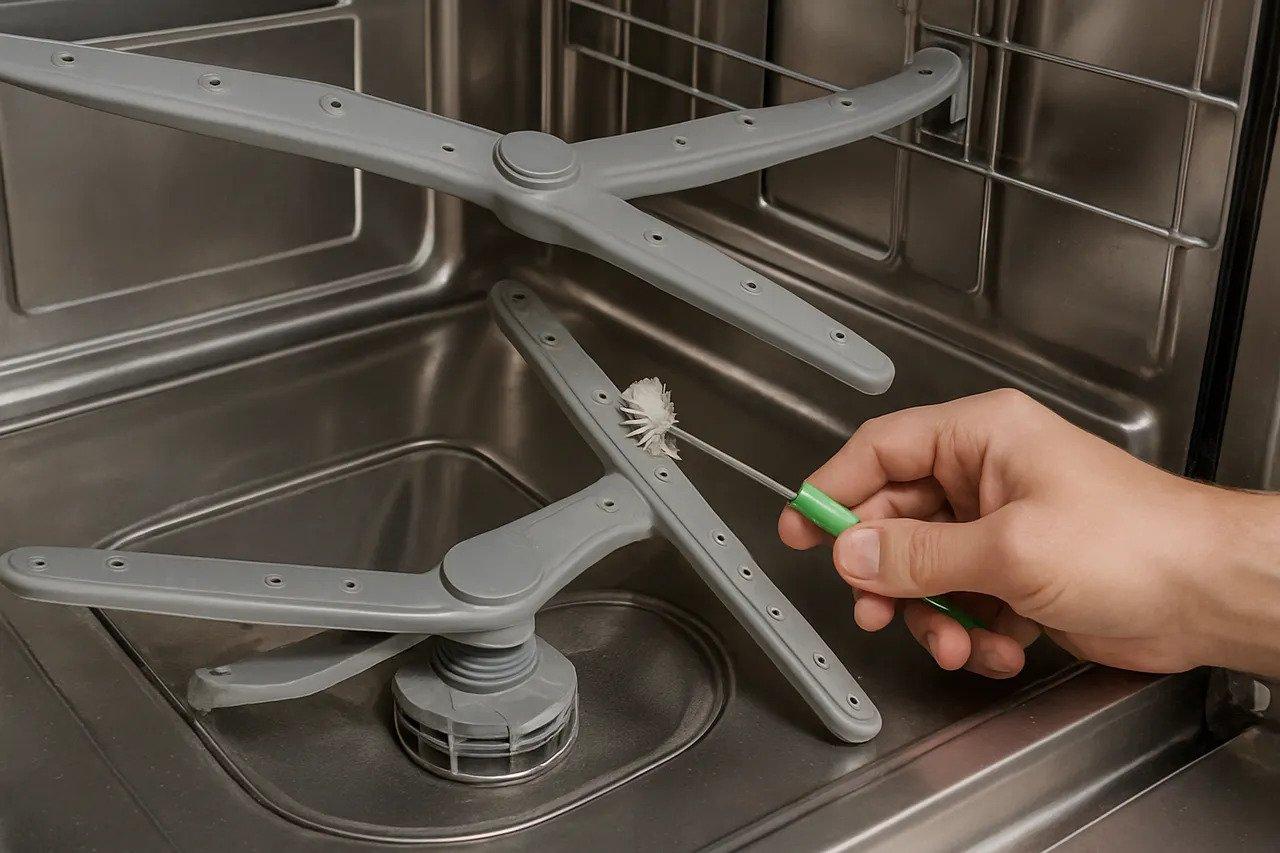How-To Guides
How to Clean Dishwasher Drain Properly
AZparts Team
Updated on November 20, 2025
10 min read
When your dishwasher isn’t draining properly, it’s often due to a blocked or dirty drain. Regular cleaning of the dishwasher hose and other components is essential to keep your machine running smoothly and extend its lifespan. In this guide, AZParts will walk you through easy steps to clean your dishwasher drain the right way, along with maintenance tips and signs that it’s time to call a professional.

1. Common Reasons Your Dishwasher Drain Gets Clogged
A clogged dishwasher is not just a nuisance as it can halt your kitchen routine, cause foul odors, and lead to expensive repairs if left unchecked. Understanding the causes of dishwasher clog is the first step to preventing them. Below are the most common reasons your dishwasher drain gets blocked, along with how each one contributes to poor drainage or even complete failure.
- Food Debris: Leftover food particles can build up in the filter or hose, leading to a blockage. Learning how to clean dishwasher drain regularly helps avoid this issue.
- Grease and Fats: Grease can solidify inside the drain, trapping debris and causing a clogged dishwasher.
- Dirty Filter Basket: A neglected filter restricts water flow, often why your dishwasher won’t drain properly.
- Clogged Drain Hose: Food, grease, or kinks in the hose are common causes of poor drainage. Knowing how to clean dishwasher drain hose is essential for keeping water flowing freely. If you prefer not to take it apart, there are methods for how to clean dishwasher drain hose without removing it.
- Garbage Disposal Issues: A blocked disposal or unremoved knockout plug can prevent proper dishwasher drainage.
- Obstructed Air Gap: A clogged air gap can stop water from draining correctly.
- Mineral Deposits: Hard water can cause scale buildup in the drain line, reducing flow.
- Improper Loading: Items falling into the drain area may block water flow.
- Incorrect Detergent: Using the wrong soap can create excess suds, hindering drainage.
- Faulty Drain Pump or Valve: Mechanical failures can stop the dishwasher from draining.
- Clogged Household Drain Line: If other drains are slow too, your main line may be blocked.

Dishwasher drain blockage (Source: AZParts)
Preventative Tip: To avoid these issues, develop a regular maintenance habit: scrape off large food bits before loading dishes, clean your filter at least once a month, and run a vinegar-based cleaning cycle every few weeks. This proactive approach helps you avoid the most common causes of dishwasher clog and keeps your appliance performing at its best.
2. How Often Should You Clean the Dishwasher Drain?
The cleaning frequency for your dishwasher drain largely depends on how often you use your dishwasher and how well you pre-rinse your dishes. However, a good general guideline is to clean the dishwasher drain at least once a month.
- Frequent Use (daily or almost daily) and Minimal Pre-Rinsing: Clean the drain monthly. More food particles are likely to end up in the drain.
- Moderate Use (several times a week) and Thorough Pre-Rinsing: You can likely extend cleaning to every 2-3 months.
- Infrequent Use (once or twice a week) and Meticulous Pre-Rinsing: Cleaning every 3-6 months might suffice.
Following a consistent cleaning frequency ensures efficiency and prevents costly repairs. Incorporate these dishwasher care tips into your home routine for best results.

You should clean dishwasher frequently for hygiene assurance (Source: Freepik)
3. How Do You Force a Dishwasher to Drain
If you open your dishwasher and notice standing water pooled at the bottom of the tub, it likely means the machine didn’t complete its drain cycle.
First, try running the dishwasher again. Sometimes, an interrupted or incomplete wash cycle can prevent the unit from draining properly. Restarting the cycle may resolve the issue.
If the water remains, try manually initiating the drain function. On most models, you can press and hold the “Cancel” or “Drain” button for about three seconds (check your user manual for specific instructions). This action usually triggers the machine to pump out any remaining water.
Should the standing water still be there after a second attempt, it’s time to investigate further. Once you’ve learned how to manually drain your dishwasher, you can begin troubleshooting potential causes—such as clogged filters, blocked hoses, or a faulty drain pump.
4. What You Need Before You Start Cleaning
Preparation makes the process smoother. Gather your dishwasher cleaning tools and essential supplies from a dishwasher maintenance kit before you begin.
4.1 Tools You'll Need
- Screwdriver for dishwasher parts removal
- Cleaning brush (a toothbrush can work too)
- Safety gloves to protect your hands from grime or sharp edges
4.2 Materials You'll Need
- Vinegar for dishwasher deodorizing and sanitizing
- Baking soda cleaning agent for scrubbing tough residue
- A dishwasher-safe cleaner for effective, appliance-friendly cleansing

You prepare carefully before cleaning dishwasher (Source: Freepik)
5. Step-by-Step Guide to Clean Your Dishwasher Drain
Keeping your dishwasher in peak condition requires more than just wiping it down occasionally. A proper dishwasher deep cleaning, including the dishwasher filter and drainpipe, helps eliminate odors, improve performance, and prevent clogs. Follow these steps for a thorough and effective clean.
5.1 Empty and Inspect the Dishwasher
To empty and inspect the dishwasher, you need to remove all dishes, utensils, and both upper, lower racks to give yourself clear access and carefully examine the interior, especially the bottom area, for standing water, food particles, or visible grime. This step not only helps in identifying potential issues but also ensures no objects are obstructing the cleaning process. These simple dishwasher inspection tips set the stage for an effective cleanup.

You empty and inspect the dishwasher (Source: AZParts)
5.2 Turn Off Dishwasher Power for Safety
You prioritize safety by turning off the power to the dishwasher and locate your home’s circuit breaker and switch off the breaker connected to your dishwasher. This precaution is essential in any cleaning involving electrical components and water. Following these dishwasher safety tips will protect you from accidental shocks as you disconnect the dishwasher and begin disassembly.

You turn off the power to the appliance before fixing (Source: AZParts)
5.3 Find and Remove the Dishwasher Filter
With power safely off, the next step is to find and remove the dishwasher filter. It is usually located at the bottom of the tub, near the spray arm, the filter may look like a mesh screen or a cylindrical piece that twists out. If you're unsure about the dishwasher filter location, refer to your user manual. You have to learning how to remove the dishwasher filter properly ensures you can clean it thoroughly without causing damage.
5.4 Clean the Filter Thoroughly
Once removed, you take time to clean the filter thoroughly and rinse it under warm water in the sink, using a soft brush or old toothbrush to dislodge trapped food particles and grease. You have to pay extra attention to the mesh and small openings as this step is crucial for cleaning the dishwasher filter and restoring optimal water flow. A dirty dishwasher filter is one of the leading causes of poor performance and unpleasant odors.

You clean the filter of the dishwasher thoroughly (Source: AZParts)
5.5 Clear Out Any Drain Blockages
A key step in unclogging the dishwasher drain is removing any visible debris that may be lodged in the drain pipe or hose. Start by inspecting the bottom of the dishwasher for food scraps, glass, or grease buildup. Use a flexible brush or wire to dislodge any debris from the drain hose or port.
If the blockage persists or your hose shows signs of wear, like kinks, brittleness, or cracks, it may be time for a replacement. AZParts offers a wide selection of genuine dishwasher drain hoses, drain pumps, and filters.
These dishwasher replacement parts ensure proper drainage and long-term performance, reducing the risk of repeated clogs. Moreover, you do not forget to check for damage around the drain pump or sump area, which can also affect how your dishwasher drains. If needed, you should swap out faulty parts with OEM-quality dishwasher components from AZParts for a reliable fix.
5.6 Freshen Up the Dishwasher Drain Area
After clearing blockages, you should take a moment to freshen up the drain area and wipe down the surrounding surfaces with a damp cloth or sponge to eliminate grime buildup. For extra deodorizing power, sprinkle a bit of baking soda around the opening. This not only targets lingering smells but contributes to cleaning dishwasher odors and leaving your appliance smelling fresh.

You fresh up the drain area of the dishwasher (Source: AZParts)
5.7 Run a Cleaning Cycle with Vinegar or Cleaner
To wrap up the process, you run a cleaning cycle with vinegar, replace the filter and dishwasher racks, then place a dishwasher-safe bowl filled with one cup of white vinegar on the top rack. You can also use a dishwasher-safe cleaner if you prefer a commercial option. Start a hot or normal wash cycle - this vinegar dishwasher cleaning step helps break down residual grease, soap scum, and clean the dishwasher drainpipe thoroughly as part of a complete dishwasher cleaning cycle.
6. Tips to Keep Your Dishwasher Drain from Clogging
Consistent dishwasher care tips and proper habits can significantly help prevent dishwasher clogs. Follow these expert-backed strategies for effective dishwasher drain maintenance:
- Remove all food particles before loading: This simple habit prevents dishwasher drain clogs caused by solid debris.
- Install a quality sink strainer: A strainer traps food waste before it enters your plumbing system—a smart move for long-term dishwasher care.
- Run hot water before each cycle: Let your sink’s hot water flow for 30 seconds before starting the dishwasher. This ensures hot water enters immediately, helping clear the drain line.
- Clean the dishwasher filter regularly: Most dishwashers have a removable filter at the bottom. Cleaning it every 1–2 weeks prevents buildup. If you’re unsure, check your manual for instructions on how to clean dishwasher drain and filter.
- Clear your garbage disposal first: If your dishwasher is connected to a disposal, run it to remove food debris that could block the drain.
- Avoid problem items: Do not place rice, pasta, coffee grounds, eggshells, excess fats, or produce stickers in the dishwasher—these are common culprits of a clogged dishwasher.
- Monthly vinegar rinse: Run an empty cycle with a cup of white vinegar on the top rack once a month. This dissolves grease and mineral deposits, helping with cleaning dishwasher hose and keeping the drain line clear.
- Check the drain hose periodically: Learn how to clean dishwasher drain hose to prevent buildup. If you prefer a simpler method, you can also try how to clean dishwasher drain hose without removing it for easy maintenance.
By integrating these tips into your routine, you can easily maintain a healthy, clog-free dishwasher system.

You clean a removable filter every 1–2 weeks to prevent buildup and dishwasher clogs
7. Frequently Asked Questions
Even with regular maintenance, dishwasher problems can still arise. Here are answers to some of the most common dishwasher drain cleaning questions to help you troubleshoot like a pro.
7.1 How Do You Unclog a Dishwasher Drain Hose?
To clear a dishwasher hose, you have to disconnect it and flush it with hot water and vinegar. A flexible brush can help unclog the dishwasher pipe effectively.
Read more: Unclog a Dishwasher Drain Fast: 5 Simple Fix-It Steps
7.2 What's the Best Cleaner for a Dishwasher Drain?
The best dishwasher cleaner is usually a mix of vinegar and baking soda, but commercial dishwasher drain cleaner products are also effective.
7.3 How Do You Remove Sludge Buildup from a Dishwasher?
To tackle dishwasher sludge removal, you need to scrub the base and drain with a brush and baking soda paste. This helps clean dishwasher buildup and improve hygiene.
7.4 Can You Use Bleach to Clean a Dishwasher Drain?
Using bleach in the dishwasher is not recommended for stainless steel interiors. If unsure, you should check your manual to determine if bleach is safe for your dishwasher.
Regular cleaning of your dishwasher hose, filter, and drain ensures optimal performance and hygiene. By following this guide, you'll extend the life of your appliance and avoid unexpected repair bills. Let AZParts be your trusted source for genuine dishwasher replacement parts and care essentials. Whether it’s filters, hoses, or maintenance kits, we’ve got you covered.
Read more:
Contact Info
Address: 8 The Green, Ste A, Dover, Delaware 19901-3618, United States
Email: support@azparts.com
Dishwasher
- 1. Common Reasons Your Dishwasher Drain Gets Clogged
- 2. How Often Should You Clean the Dishwasher Drain?
- 3. How Do You Force a Dishwasher to Drain
- 4. What You Need Before You Start Cleaning
- 5. Step-by-Step Guide to Clean Your Dishwasher Drain
- 6. Tips to Keep Your Dishwasher Drain from Clogging
- 7. Frequently Asked Questions
Further Reading
Further Reading




_1748246700.jpg&w=3840&q=75)
